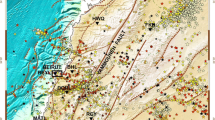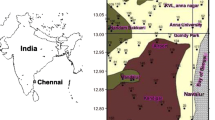Abstract
Weak and strong ground motions were numerically predicted for three stations of the Ashigara Valley test site. The prediction was based on the records from a rock-outcrop station, one weak-motion record from a surface-sediments station, and the standard geotechnical model. The data were provided by the Japanese Working Group on the Effects of Surface Geology as a part of an international experiment. The finite-difference method for SH waves in a 2-D linear viscoelastic medium (a causalQ model) was employed.
Comparison with the real records shows that at two stations the predictions fit better than at the third one. Strangely, the two better predictions were for stations situated at larger distances from the reference rock station (one station was on the surface, the other in a borehole). The strong ground motion (the peak acceleration of about 200 cm s−2) was not predicted qualitatively worse than the weak motion (8 cm s−2). A less sophisticated second prediction (not submitted during the experiment), in which we did not attempt to fit the available weak-motion record at the sedimentary station, agrees with the reality significantly better.
Similar content being viewed by others
References
Bard, P. Y. and Figueras, S.: 1992, Ashigara Valley blind prediction test. Results obtained with various models based on the discrete wavenumber method,Res. Report, Observatoire de Grenoble, LGIT-IRIGM, Grenoble, France.
Cramer, C. H.: 1992, Weak motion observations and modelling for the Turkey Flat, USA, Site effects test area near Parkfield, California, inProc. of the Internat. Symp. on the Effects of Surface Geology on Seismic Motion (25–27 March, 1992, Odawara, Japan), Vol. II, Association for Earthquake Disaster Prevention, Tokyo, Japan, pp. 21–26.
Cramer, C. H. and Real, C. R.: 1992, A statistical analysis of submitted site-effects predictions for the weak motion blind prediction test conducted at the Turkey Flat, USA, Site Effects Test Area near Parkfield, California, inProc. of the Internat. Symp. on the Effects of Surface Geology on Seismic Motion (25–27 March, 1992, Odawara, Japan), Vol. II, Association for Earthquake Disaster Prevention, Tokyo, Japan, pp. 15–20.
Faccioli, E. and Paolucci, R.: 1992, 2D and 1D ground motion prediction at Ashigara Valley by pseudospectral method, inProc. of the Internat. Symp. on the Effects of Surface Geology on Seismic Motion (25–27 March, 1992, Odawara, Japan), Vol. II, Association for Earthquake Disaster Prevention, Tokyo, Japan, pp. 89–90.
Futterman, W. I.: 1962, Dispersive body waves,J. Geophys. Res. 67, 5279–5291.
Kjartansson, E.: 1979, ConstantQ wave propagation and attenuation,J. Geophys. Res. 84, 4737–4748.
Kudo, K.: 1992, Earthquake motions: given and blinded data, inProc. of the Internat. Symp. on the Effects of Surface Geology on Seismic Motion (25–27 March, 1992, Odawara Japan), Vol. II, Association for Earthquake Disaster Prevention, Tokyo, Japan, pp. 53–60.
Midorikawa, S.: 1992, A statistical analysis of submitted predictions for the Ashigara Valley blind prediction test, inProc. of the Internat. Symp. on the Effects of Surface Geology on Seismic Motion (25–27 March, 1992, Odawara, Japan), Vol. II, Association for Earthquake Disaster Prevention, Tokyo, Japan, pp. 65–78.
Moczo, P.: 1989, Finite-difference technique for SH waves in 2-D media using irregular grids — application to the seismic response problem,Geophys. J. Int. 99, 321–329.
Moczo, P. and Bard, P.-Y.: 1992, Wave diffraction, amplification and differential motion near strong lateral discontinuities,Bull. Seismol. Soc. Am. 83, 85–106.
Proceedings: 1992,Proceedings of the Internat. Symp. on the Effects of Surface Geology on Seismic Motion (25–27 March, 1992, Odawara, Japan), Vol. II. Association for Earthquake Disaster Prevention, Tokyo, Japan.
Sawada, Y.: 1992, Geotechnical data, inProc. of the Internat. Symp. on the Effects of Surface Geology on Seismic Motion (25–27 March, 1992, Odawara, Japan), Vol. II, Association for Earthquake Disaster Prevention, Tokyo, Japan, pp. 29–42.
Tucker, B. 1992, An analysis of the past and some opinions for the future of our international experiments on effects of surface geology on seismic motion, inProc. of the Internat. Symp. on the Effects of Surface Geology on Seismic Motion (25–27 March, 1992, Odawara, Japan), Vol. II, Association for Earthquake Disaster Prevention, Tokyo, Japan, pp. 3–8.
Zahradník, J, Jech, J., and Moczo, P.: 1990, Absorption correction for computation of a seismic ground response,Bull. Seismol. Soc. Am. 80, 1382–1387.
Zahradník, J., Jech, J., and Barták, V.: 1991, Predicting ground-motion variations at the Turkey-Flat test site, California,Pageoph 137, 63–84.
Author information
Authors and Affiliations
Rights and permissions
About this article
Cite this article
Zahradník, J., Moczo, P. & Hron, F. Blind prediction of the site effects at Ashigara Valley, Japan, and its comparison with reality. Nat Hazards 10, 149–170 (1994). https://doi.org/10.1007/BF00643449
Received:
Issue Date:
DOI: https://doi.org/10.1007/BF00643449




